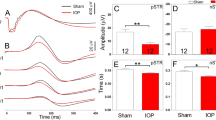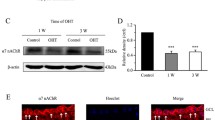Abstract
Retinal ganglion cells process the visual signal and transmit it along their axons in the optic nerve to the brain. Molecular, immunohistochemical, and functional analyses indicate that the majority of retinal ganglion cells express the ionotropic P2X7 receptor. Stimulation of the receptor can lead to a rise in intracellular calcium and cell death, although death does not involve the opening of a large diameter pore. Adenosine acting at A3 receptors can attenuate the rise in calcium and death accompanying P2X7 receptor activation, suggesting that dephosphorylation of ATP into adenosine is neuroprotective and that the balance of extracellular purines can influence neuronal survival. Increased intraocular pressure can lead to release of excessive extracellular ATP in the retina and damage ganglion cells by acting on P2X7 receptors, implicating a role for the receptor in the loss of ganglion cell activity in glaucoma. In summary, the activation of P2X7 receptors has both physiologic and pathophysiologic implications for ganglion cell function. These characteristics may also provide an insight into the contributions the P2X7 receptor makes to neurons elsewhere.


Similar content being viewed by others
References
Anderson C, Nedergaard M (2006) Emerging challenges of assigning P2X(7) receptor function and immunoreactivity in neurons. Trends Neurosci 29:257–262
Sperlagh B, Vizi ES, Wirkner K, Illes P (2006) P2X7 receptors in the nervous system. Prog Neurobiol 78:327–346
Brandle U, Kohler K, Wheeler-Schilling TH (1998) Expression of the P2X7-receptor subunit in neurons of the rat retina. Brain Res Mol Brain Res 62:106–109
Wheeler-Schilling TH, Marquordt K, Kohler K, Guenther E et al (2001) Identification of purinergic receptors in retinal ganglion cells. Brain Res Mol Brain Res 92:177–180
Resta V, Novelli E, Di Virgilio F, Galli-Resta L (2005) Neuronal death induced by endogenous extracellular ATP in retinal cholinergic neuron density control. Development 132:2873–2882
Ishii K, Kaneda M, Li H, Rockland KS et al (2003) Neuron-specific distribution of P2X7 purinergic receptors in the monkey retina. J Comp Neurol 459:267–277
Sim JA, Young MT, Sung HY, North RA et al (2004) Reanalysis of P2X(7) receptor expression in rodent brain. J Neurosci 24:6307–6314
Puthussery T, Fletcher EL (2004) Synaptic localization of P2X7 receptors in the rat retina. J Comp Neurol 472:13–23
Cheewatrakoolpong B, Gilchrest H, Anthes JC, Greenfeder S (2005) Identification and characterization of splice variants of the human P2X7 ATP channel. Biochem Biophys Res Comm 332:17–27
Pintor P, Sánchez-Nogueiro J, Irazu M, Mediero A et al (2004) Immunolocalisation of P2Y receptors in the rat eye. Purinergic Signal 1:83–90
Cowlen MS, Zhang VZ, Warnock L, Moyer CF et al (2003) Localization of ocular P2Y2 receptor gene expression by in situ hybridization. Exp Eye Res 77:77–84
Fries JE, Wheeler-Schilling TH, Kohler K, Guenther E (2004) Distribution of metabotropic P2Y receptors in the rat retina: a single-cell RT-PCR study. Brain Res Mol Brain Res 130:1–6
Fries JE, Wheeler-Schilling TH, Guenther E, Kohler K (2004) Expression of P2Y1, P2Y2, P2Y4, and P2Y6 receptor subtypes in the rat retina. Invest Ophthalmol Vis Sci 45:3410–3417
Greenwood D, Yao WP, Housley GD (1997) Expression of the P2X2 receptor subunit of the ATP-gated ion channel in the retina. Neuroreport 8:1083–1088
Shigematsu Y, Shimoda Y, Kaneda M (2007) Distribution of immunoreactivity for P2X3, P2X5, and P2X6-purinoceptors in mouse retina. J Mol Histol 38:369–371
Taschenberger H, Juttner R, Grantyn R (1999) Ca2+-permeable P2X receptor channels in cultured rat retinal ganglion cells. J Neurosci 19:3353–3366
North RA (2002) Molecular physiology of P2X receptors. Physiol Rev 82:1013–1067
Egan TM, Khakh BS (2004) Contribution of calcium ions to P2X channel responses. J Neurosci 24:3413–3420
Zhang X, Zhang M, Laties AM, Mitchell CH (2005) Stimulation of P2X7 receptors elevates Ca2+ and kills retinal ganglion cells. Invest Ophthalmol Vis Sci 46:2183–2191
Bo X, Jiang LH, Wilson HL, Kim M et al (2003) Pharmacological and biophysical properties of the human P2X5 receptor. Mol Pharmacol 63:1407–1416
Fedorov IV, Rogachevskaja OA, Kolesnikov SS (2007) Modeling P2Y receptor-Ca2+ response coupling in taste cells. Biochim Biophys Acta 1768:1727–1740
Jiang LH, Mackenzie AB, North RA, Surprenant A (2000) Brilliant blue G selectively blocks ATP-gated rat P2X(7) receptors. Mol Pharmacol 58:82–88
Bianchi BR, Lynch KJ, Touma E, Niforatos W et al (1999) Pharmacological characterization of recombinant human and rat P2X receptor subtypes. Eur J Pharmacol 376:127–138
North RA, Surprenant A (2000) Pharmacology of cloned P2X receptors. Annu Rev Pharmacol Toxicol 40:563–580
Surprenant A, Rassendren F, Kawashima E, North RA et al (1996) The cytolytic P2Z receptor for extracellular ATP identified as a P2X receptor (P2X7). Science 272:735–738
Choi DW (1992) Excitotoxic cell death. J Neurobiol 23:1261–1276
Beigi RD, Kertesy SB, Aquilina G, Dubyak GR (2003) Oxidized ATP (oATP) attenuates proinflammatory signaling via P2 receptor-independent mechanisms. Br J Pharmacol 140:507–519
von Kügelgen I (2006) Pharmacological profiles of cloned mammalian P2Y-receptor subtypes. Pharmacol Ther 110:415–432
Resta V, Novelli E, Vozzi G, Scarpa C et al (2007) Acute retinal ganglion cell injury caused by intraocular pressure spikes is mediated by endogenous extracellular ATP. Eur J Neurosci 25:2741–2754
Hu H, Lu W, Laties AM, Mitchell CH (2008) Stimulation of P2X7 receptor kills rat retinal ganglion cells in vivo. Invest Ophthalmol Vis Sci 49:ARVO E-Abstract 2063
Virginio C, MacKenzie A, North RA, Surprenant A (1999) Kinetics of cell lysis, dye uptake and permeability changes in cells expressing the rat P2X7 receptor. J Physiol 519:335–346
Faria RX, Defarias FP, Alves LA (2005) Are second messengers crucial for opening the pore associated with P2X7 receptor? Am J Physiol Cell Physiol 288:C269–C271
Wilson HL, Wilson SA, Surprenant A, North RA (2002) Epithelial membrane proteins induce membrane blebbing and interact with the P2X7 receptor C terminus. J Biol Chem 277:34017–34023
Pelegrin P, Surprenant A (2006) Pannexin-1 mediates large pore formation and interleukin-1beta release by the ATP-gated P2X7 receptor. EMBO J 25:5071–5082
Innocenti B, Pfeiffer S, Zrenner E, Kohler K et al (2004) ATP-induced non-neuronal cell permeabilization in the rat inner retina. J Neurosci 24:8577–8583
Mitchell CH, Zhang M, Zhang X, Lu W et al (2006) Neuronal death evoked by the P2X7 receptor mediated by the NMDA receptor. Invest Ophthalmol Vis Sci 47:ARVO E-abstract 2589
Newman EA (2003) Glial cell inhibition of neurons by release of ATP. J Neurosci 23:1659–1666
Newman EA (2001) Propagation of intercellular calcium waves in retinal astrocytes and Müller cells. J Neurosci 21:2215–2223
Zhang X, Zhang M, Laties AM, Mitchell CH (2006) Balance of purines may determine life or death as A3 adenosine receptors prevent loss of retinal ganglion cells following P2X7 receptor stimulation. J Neurochem 98:566–575
Jacobson KA, Park KS, Jiang JL, Kim YC et al (1997) Pharmacological characterization of novel A3 adenosine receptor-selective antagonists. Neuropharmacology 36:1157–1165
Jin X, Shepherd RK, Duling BR, Linden J (1997) Inosine binds to A3 adenosine receptors and stimulates mast cell degranulation. J Clin Invest 100:2849–2857
Kvanta A, Seregard S, Sejersen S, Kull B et al (1997) Localization of adenosine receptor messenger RNAs in the rat eye. Exp Eye Res 65:595–602
Yaar R, Lamperti ED, Toselli PA, Ravid K (2002) Activity of the A3 adenosine receptor gene promoter in transgenic mice: characterization of previously unidentified sites of expression. FEBS Lett 532:267–272
Zhang M, Budak MT, Lu W, Khurana TS et al (2006) Identification of the A3 adenosine receptor in rat retinal ganglion cells. Mol Vis 12:937–948
Hartwick ATE, Lalonde MR, Barnes S, Baldridge WH (2004) Adenosine A(1)-receptor modulation of glutamate-induced calcium influx in rat retinal ganglion cells. Invest Ophthalmol Vis Sci 45:3740–3748
Dolphin AC (2003) G protein modulation of voltage-gated calcium channels. Pharmacol Rev 55:607–627
Sun X, Barnes S, Baldridge WH (2002) Adenosine inhibits calcium channel currents via A1 receptors on salamander retinal ganglion cells in a mini-slice preparation. J Neurochem 81:550–556
Calton JL, Kang MH, Wilson WA, Moore SD (2000) NMDA-Receptor-dependent synaptic activation of voltage-dependent calcium channels in basolateral amygdala. J Neurophysiol 83:685–692
Brater M, Li SN, Gorodezkaya IJ, Andreas K et al (1999) Voltage-sensitive Ca2+ channels, intracellular Ca2+ stores and Ca2+-release-activated Ca2+ channels contribute to the ATP-induced [Ca2+]i increase in differentiated neuroblastoma x glioma NG 108–15 cells. Neurosci Lett 264:97–100
Burnstock G (1999) Release of vasoactive substances from endothelial cells by shear stress and purinergic mechanosensory transduction. J Anat 194:335–342
Ferguson D, Kennedy I, Burton T (1997) ATP is released from rabbit urinary bladder epithelial cells by hydrostatic pressure changes–a possible sensory mechanism? J Physiol 505:503–511
Reigada D, Mitchell C (2005) Release of ATP from retinal pigment epithelial cells involves both CFTR and vesicular transport. Am J Physiol Cell Physiol 288:C132–C140
Ventura LM, Porciatti V (2005) Restoration of retinal ganglion cell function in early glaucoma after intraocular pressure reduction: a pilot study. Ophthalmology 112:20–27
Zhang X, Li A, Ge J, Reigada D et al (2007) Acute increase of intraocular pressure releases ATP into the anterior chamber. Exp Eye Res 85:637–643
Reigada D, Lu W, Zhang M, Mitchell CH (2008) Elevated pressure triggers a physiological release of ATP from the retina: possible role for pannexin hemichannels. Neuroscience doi:10.1016/j.neuroscience.2008.08.036
Cepurna WO, Jia L, Johnson EC, Morrison JC (2006) Aging increases susceptibility to intraocular pressure (IOP) and alters retinal gene expression responses in the rat. Invest Ophthalmol Vis Sci 47:ARVO E-abstract 1243
Acknowledgements
This work was supported by grants EY-015537 and EY-013434 from the NIH to CHM, and EY-01583 to the Vision Research Center of the University of Pennsylvania, by a University Research Foundation award from the University of Pennsylvania to CHM, by the Jody Sack Fund to XZ, MZ, and HH. The authors would like to thank Alan Laties for many useful discussions.
Author information
Authors and Affiliations
Corresponding author
Additional information
This article has previously been published in issue 4/4, under doi10.1007/s11302-008-9125-z.
Rights and permissions
About this article
Cite this article
Mitchell, C.H., Lu, W., Hu, H. et al. The P2X7 receptor in retinal ganglion cells: A neuronal model of pressure-induced damage and protection by a shifting purinergic balance. Purinergic Signalling 5, 241–249 (2009). https://doi.org/10.1007/s11302-009-9142-6
Received:
Accepted:
Published:
Issue Date:
DOI: https://doi.org/10.1007/s11302-009-9142-6




